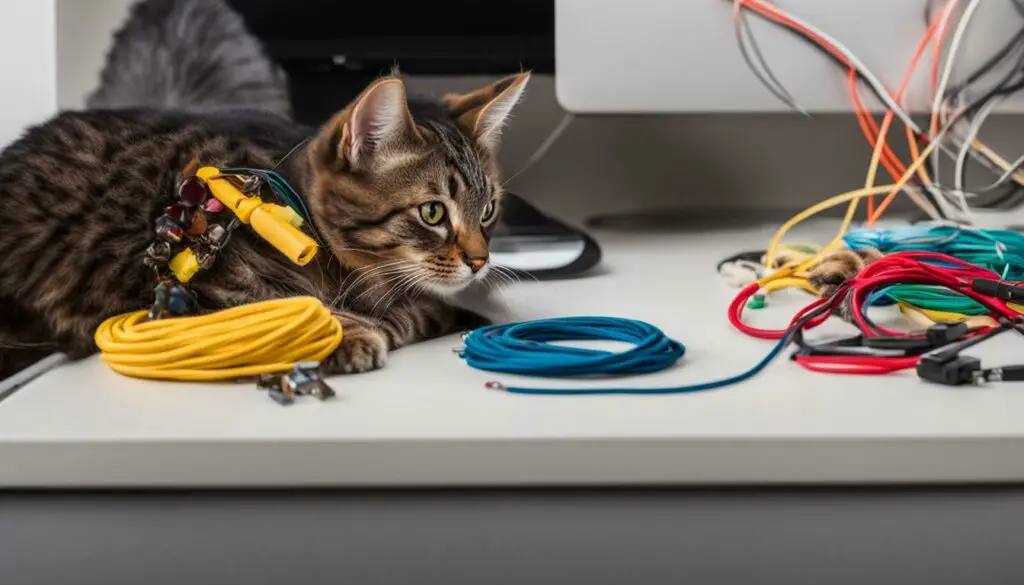Cats chewing on electrical cords can pose serious hazards, but with the right preventative measures, you can keep your furry friend safe. Whether it’s out of curiosity, boredom, dental issues, OCD, nutritional deficiency, or stress, it’s important to address this behavior promptly to prevent potential injuries and electrical accidents.
Key Takeaways:
- Use rubber or plastic cord covers to prevent cats from accessing and chewing on cords.
- Provide alternative chewing options such as rubber chew toys or cat grass to redirect their chewing behavior.
- Increase interaction and playtime with your cat to keep them mentally stimulated and less likely to engage in cord chewing.
- Consider using store-bought apple spray as a safe and effective deterrent against cord chewing.
- Rearrange furniture to cover up cords and make them less accessible to curious cats.
Understanding Why Cats Chew Cords and the Risks Involved
Cats may chew on cords due to various reasons, including curiosity, boredom, dental issues, OCD, nutritional deficiency, or stress. While this behavior may seem harmless, it can pose significant risks to both cats and the safety of your home. Understanding why cats chew cords and the potential dangers involved is essential in finding effective solutions to prevent feline cord chewing incidents.
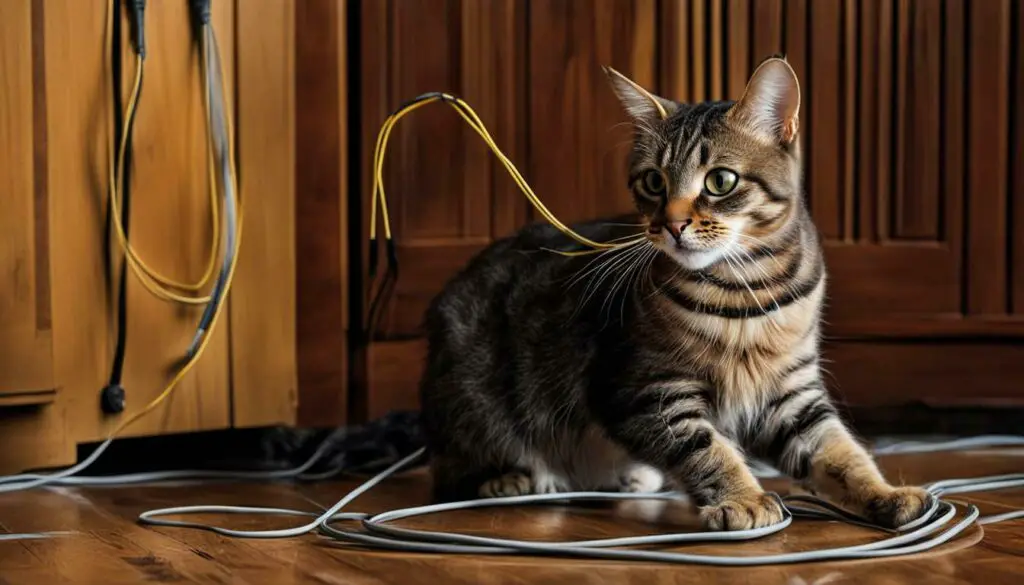
When cats chew on cords, they expose themselves to the risk of electrical shock, burns, or even choking hazards. The electrical current running through the cords can cause severe injuries, ranging from burns to fatal electrocution. Additionally, chewing on cords can lead to damaged electrical systems, resulting in power outages or even house fires. It is crucial to address this behavior promptly to ensure the safety of your cat and your home.
To prevent feline cord chewing incidents, it is essential to cat-proof your home by taking proactive measures. One effective strategy is to use rubber or plastic cord covers. These covers create a physical barrier, making it difficult for cats to access and chew on cords. By enclosing the cords, you can significantly reduce the chances of your cat engaging in this potentially dangerous behavior.
Providing alternative chewing options for your cat is another effective approach. By offering rubber chew toys or cat grass, you give your cat a safe and appropriate outlet for their chewing needs. These alternatives can redirect their chewing behavior away from cords and towards more suitable objects. Additionally, increasing interaction and playtime with your cat can help prevent boredom and fulfill their natural instincts, reducing the likelihood of them resorting to cord chewing.
Key Takeaways:
- Cats may chew on cords due to various reasons, including curiosity, boredom, dental issues, OCD, nutritional deficiency, or stress.
- Chewing on cords can pose risks such as electrical shock, burns, or choking hazards for cats.
- Using rubber or plastic cord covers and providing alternative chewing options can help prevent feline cord chewing incidents.
- Increasing interaction and playtime with your cat can redirect their chewing behavior and fulfill their natural instincts.
In conclusion, understanding why cats chew cords and the risks involved is crucial for ensuring the safety of your cat and your home. By implementing preventive measures, such as using cord covers, providing alternative chewing options, and increasing interaction with your cat, you can effectively prevent feline cord chewing incidents and create a safe environment for your furry friend.
Rubber or Plastic Cord Covers: A Simple Solution
Using rubber or plastic cord covers is an effective way to physically block your cat’s access to cords and protect them from potential harm. These covers provide a barrier between your cat and the cords, preventing them from chewing on them and reducing the risk of electrical shocks or injuries. They are easy to install and can be found in pet supply stores or online.
When choosing cord covers, look for durable materials that are resistant to chewing and non-toxic for your cat. Rubber covers are often preferred as they are flexible, making it difficult for cats to grip and chew through. Plastic covers are another option, but make sure they are made of a sturdy material that cannot easily be chewed or swallowed.
To install the cord covers, simply wrap them around the cords and secure them in place. It’s important to cover the entire length of the cords, including any exposed sections, to ensure that your cat cannot access them. Additionally, consider using cable clips or ties to keep the cords organized and out of your cat’s reach.
Remember that cord covers are just one part of cat-proofing your home. It’s also essential to provide alternative chewing options, increase interaction and playtime with your cat, and address any underlying health or behavioral issues. By taking these proactive measures, you can create a safe environment for your cat and prevent them from chewing on electrical cords.
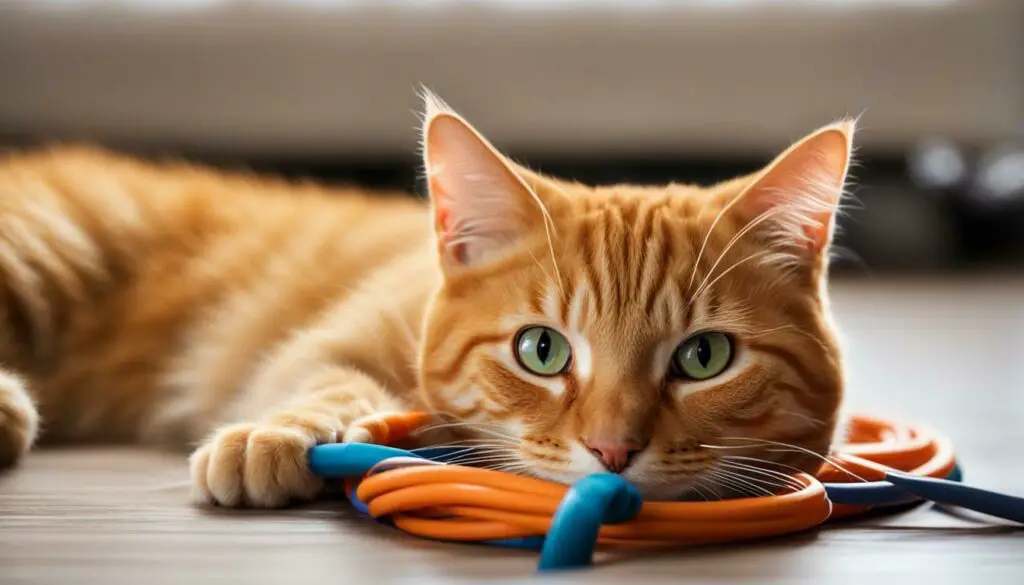
Table:
| Advantages of Rubber or Plastic Cord Covers | Disadvantages of Rubber or Plastic Cord Covers |
|---|---|
| Effective physical barrier against cord chewing | Some cats may still attempt to chew through the covers |
| Easy to install and remove | May not be aesthetically pleasing |
| Durable and resistant to chewing | May not fit all types of cords |
| Non-toxic for cats | Need to cover the entire length of the cords |
Providing Alternative Chewing Options for Your Cat
By offering alternative chewing options, you can satisfy your cat’s instinctual need to chew and minimize their interest in cords. Cats often chew on cords due to curiosity, boredom, dental issues, OCD, nutritional deficiency, or stress. Providing them with appropriate objects to chew on can redirect their attention away from cords and keep them entertained.
One option is to introduce rubber chew toys specifically designed for cats. These toys are durable and safe for your cat to chew on, providing them with a satisfying chewing experience. Be sure to choose toys that are the correct size for your cat and made from non-toxic materials. You can also try offering cat grass, which not only serves as an alternative chewing option but also provides nutritional benefits.
Another idea is to engage your cat in interactive playtime. Dedicate regular play sessions to keep them mentally stimulated and physically active. Use toys that allow them to chase, pounce, and engage their hunting instincts. This can help alleviate boredom and reduce the likelihood of them turning to cords as a source of entertainment.
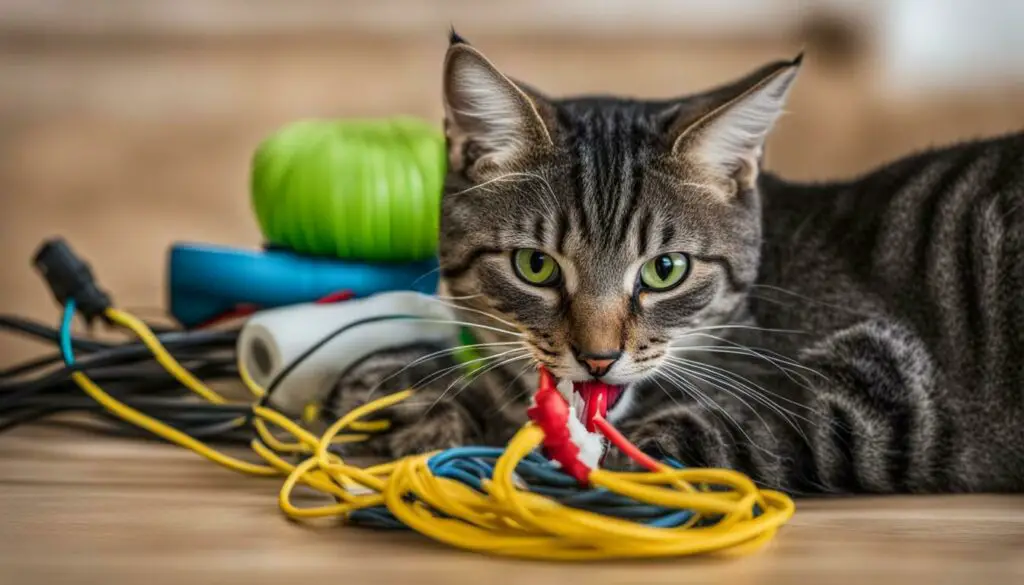
Remember, each cat has their own preferences, so it may take some trial and error to find the right alternative chewing options that your cat enjoys. Be patient and persistent in finding the toys and activities that capture their interest and keep them away from cords.
Increasing Interaction and Playtime with Your Cat
Cats often chew cords out of boredom, so increasing their mental and physical stimulation through interactive play and regular exercise can help deter them from chewing cables. Providing your cat with plenty of playtime and attention can redirect their chewing behavior towards more appropriate outlets.
Engage in interactive play sessions with your cat using toys such as feather wands, laser pointers, or treat puzzles. This not only keeps them physically active but also mentally stimulated. Set aside dedicated playtime each day to ensure your cat gets the attention and exercise they need.
In addition to play, providing environmental enrichment is crucial. Create a cat-friendly space in your home with scratching posts, climbing trees, and hiding spots. This allows your cat to engage in natural behaviors, reducing boredom that may lead to cord chewing.
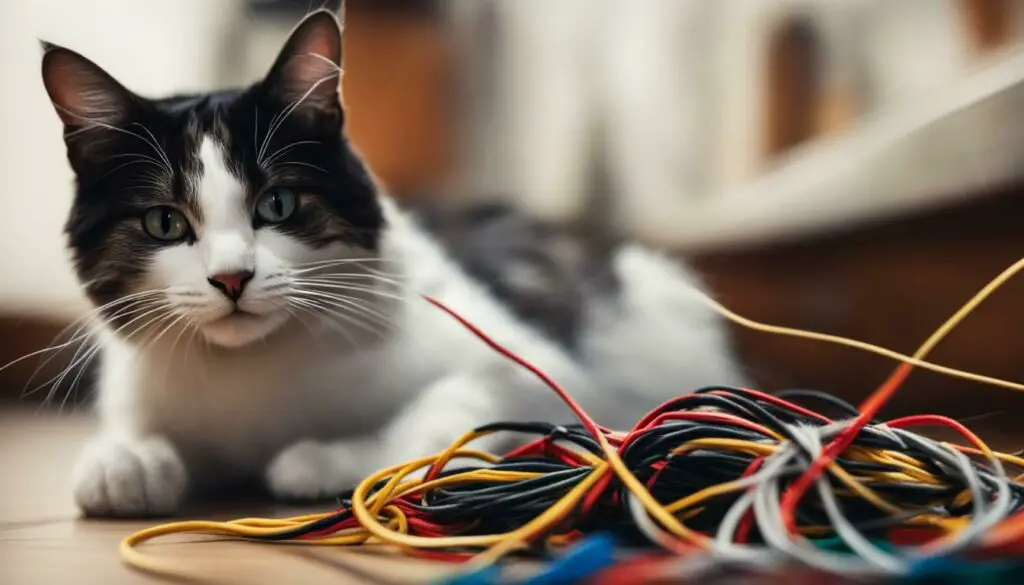
Remember, each cat is unique, so it is important to experiment with different toys and play styles to find what best captivates your feline friend’s interest and prevents cord chewing. Always supervise playtime to ensure the safety of your cat and to guide them towards appropriate play behavior.
Another effective way to increase interaction with your cat is to incorporate food puzzles and interactive feeding toys. These challenging toys make cats work for their meals, keeping them mentally engaged and less likely to resort to destructive chewing. Consult with your veterinarian to find the best options for your cat’s dietary needs.
By providing ample interaction and playtime, you can keep your cat happy, mentally stimulated, and less inclined to chew on cords. Remember to monitor their behavior and maintain a safe environment by utilizing other preventive measures, such as cord covers and deterrent sprays.
| Benefits of increasing interaction and playtime | How to increase interaction and playtime |
|---|---|
|
|
Using Store-Bought Apple Spray as a Deterrent
Store-bought apple spray, specifically formulated to be safe for cats, can be applied to cords as a taste deterrent to discourage chewing behavior. This spray has a strong scent of apple that cats find unappealing, making them less likely to chew on cords. Simply spray the apple deterrent onto the cords, ensuring that they are thoroughly coated.
In addition to the unpleasant taste, the scent of the apple spray can also deter cats from approaching the cords. It is important to apply the spray regularly, especially after cleaning or moving cords, as the scent may wear off over time.
| Benefits of Using Apple Spray as a Deterrent: |
|---|
| 1. Safe for cats: The apple spray is specially designed to be non-toxic and harmless to cats. |
| 2. Easy to use: Simply spray the deterrent onto the cords to protect them from chewing. |
| 3. Cost-effective: Apple spray is an affordable solution compared to potential cord replacements caused by chewing damage. |
Remember, while apple spray can be an effective deterrent, it should not be the only method used to prevent cord chewing. It is important to provide alternative chewing options, increase interaction and playtime with your cat, and consider other preventive measures mentioned in this article to ensure the safety of your cat and your cords.
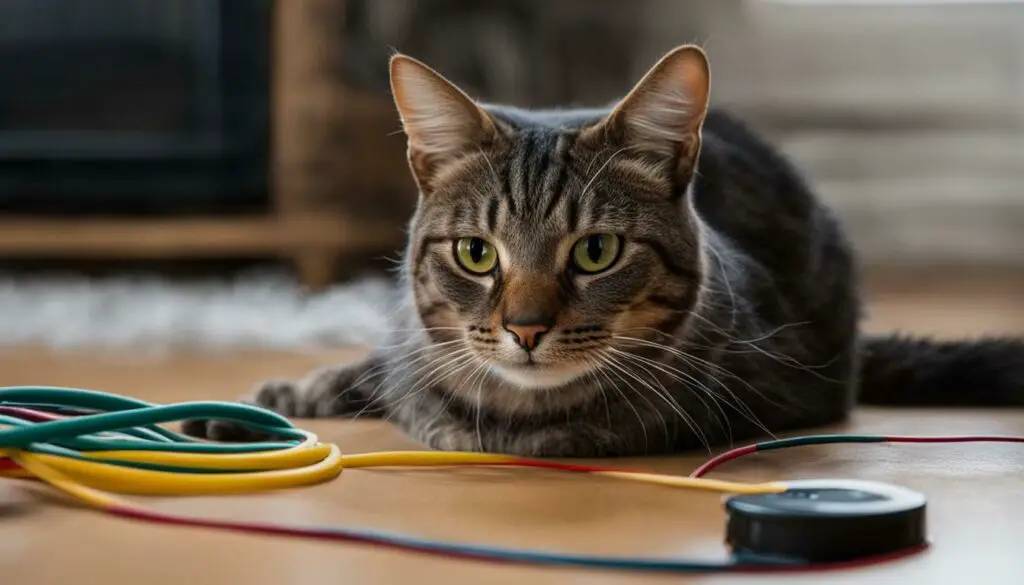
Rearranging Furniture to Cover Up Cords
By strategically positioning furniture to cover cords, you can create a barrier that will discourage cats from reaching and chewing on them. This is a simple yet effective solution to protect your cables and prevent potential hazards.
Start by identifying the areas where your cat has easy access to cords. Look for cords that are within their reach, such as those behind entertainment centers, desks, or bedside tables. Rearrange the furniture in these areas to create obstacles and hide the cords from your cat’s view.
To further secure the cords, use zip ties or cord clips to neatly bundle them together. This not only helps with organizing the cords but also minimizes the temptation for cats to explore and chew on them. Make sure to position the furniture in a way that completely covers the cords and prevents any gaps where your cat can squeeze through.
Remember, supervision is key. Even with furniture covering the cords, it’s important to keep an eye on your cat to ensure they don’t find a way to access them. Regularly check the area to ensure that furniture hasn’t been moved or shifted, and that cords remain hidden and unreachable.
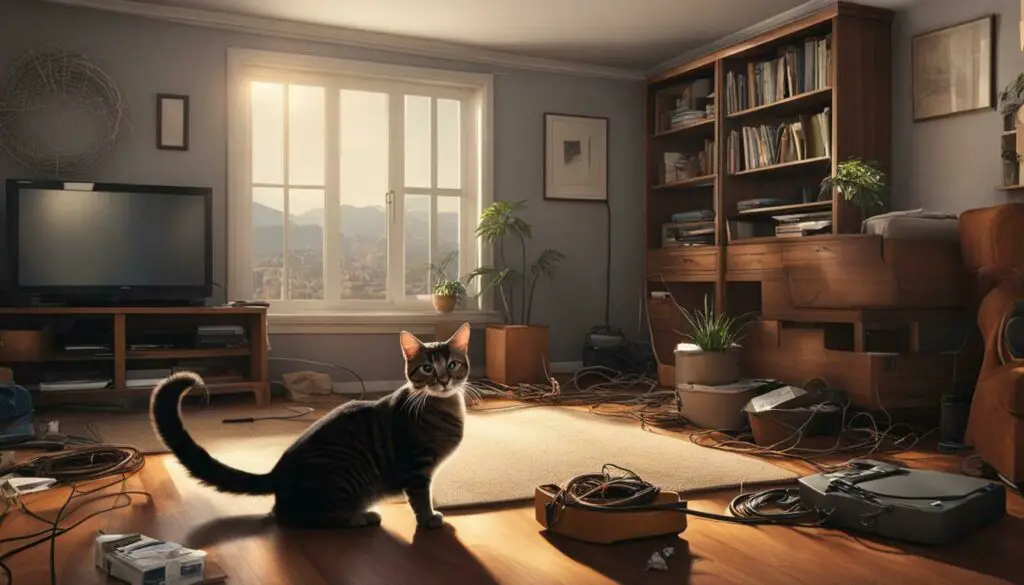
| Benefits of Rearranging Furniture to Cover Up Cords: |
|---|
| Create a physical barrier that deters cats from accessing cords |
| Minimize the risk of injury and electrical hazards |
| Ensure a tidy and organized living space |
| Prevent potential damage to electronic devices and appliances |
Veterinary Checkup for Health and Dental Issues
It’s crucial to consult with your veterinarian to rule out any medical issues, such as dental problems, that may be causing your cat to gnaw on cords. Dental issues, in particular, can be a common underlying cause of this behavior. Cats may chew on cords to alleviate dental pain or discomfort, as they seek relief by applying pressure to their teeth and gums. Your veterinarian can examine your cat’s oral health, looking for signs of inflammation, tooth decay, or other dental problems that may be contributing to their cord chewing behavior.
In addition to dental issues, your vet can also determine if there are any other underlying medical conditions that may be causing your cat to chew on cords. Certain nutritional deficiencies or stress-related disorders can manifest in this behavior. By conducting a thorough examination and running any necessary tests, your vet can diagnose and treat any medical issues that may be contributing to your cat’s cord chewing behavior.
During the veterinary checkup, be sure to provide your vet with a detailed history of your cat’s behavior, including when the cord chewing started, any changes in their environment or routine, and any other behavioral or health changes you have noticed. This information can help your vet in their evaluation and guide them in developing an appropriate treatment plan.
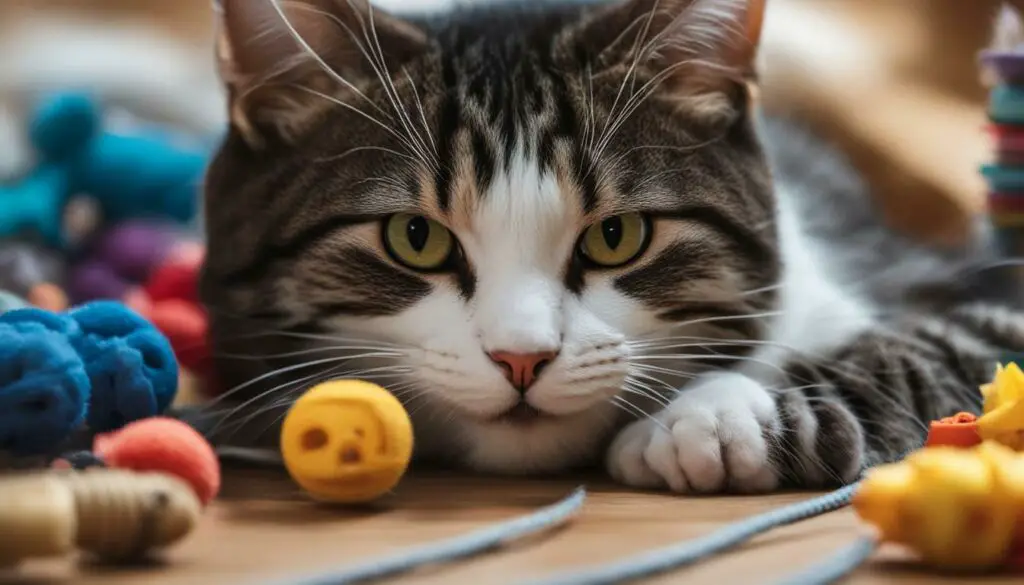
Summary:
- Consult with your veterinarian to rule out any medical issues causing your cat to gnaw on cords.
- Common dental problems can lead to cats chewing on cords to alleviate pain or discomfort.
- Your vet can examine your cat’s oral health and check for signs of inflammation, tooth decay, or other dental issues.
- Underlying medical conditions such as nutritional deficiencies or stress-related disorders can also contribute to cord chewing behavior.
- Provide your vet with a detailed history of your cat’s behavior to aid in their evaluation and treatment plan.
Signs of Injury from Cord Chewing
Burn marks, excessive drooling, or other signs of injury from cord chewing should be taken seriously, and immediate veterinary attention should be sought. These signs indicate that your cat’s cord chewing behavior has caused harm and poses a potential danger to their health.
Cord chewing can result in electrical burns, broken teeth, or even electric shock if the cord is plugged in. Burn marks on the cat’s fur or mouth are clear indicators of contact with live wires. Excessive drooling may suggest an oral injury or discomfort caused by chewing on cords. It is essential to address these issues promptly to prevent further harm.
During your visit to the vet, they will assess the extent of the injury and provide appropriate treatment. This may include administering pain medication, cleaning and dressing wounds, or performing dental procedures if necessary. They will also guide you on how to prevent further incidents and protect your cat from cord-related injuries in the future.
| Signs of Injury from Cord Chewing: | Action Steps: |
|---|---|
| Burn marks on fur or mouth | Seek immediate veterinary attention |
| Excessive drooling | Take your cat to the vet for an examination |
| Visible oral injuries | Ensure prompt veterinary intervention |
| Dental pain or broken teeth | Consult with a veterinarian to address dental issues |
| Electric shock | Emergency veterinary care is necessary |
Remember, prevention is key to keeping your cat safe from cord chewing risks. By implementing the strategies discussed in this article and being vigilant about your cat’s behavior, you can protect them from potential harm and ensure their overall well-being.
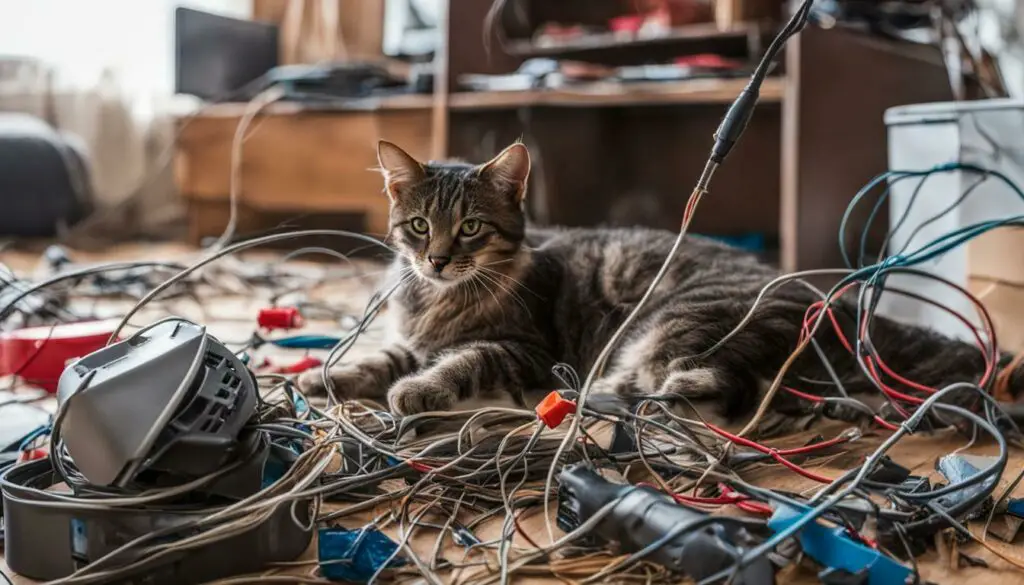
Conclusion
By implementing these practical and effective strategies, you can create a safer environment for your cat and prevent them from chewing on cords. If your cat is exhibiting this behavior, it’s important to address it promptly to avoid potential hazards and injuries.
Cats may chew on cords out of curiosity, boredom, dental issues, OCD, nutritional deficiency, or stress. To prevent cats from chewing cords, consider using rubber or plastic cord covers. These covers act as a physical barrier, making cords less accessible to your furry friend.
Providing alternative chewing options is another great way to redirect your cat’s attention away from cords. Offer rubber chew toys or cat grass to satisfy their chewing instincts. Additionally, increasing interaction and playtime with your cat can keep them mentally stimulated and less likely to engage in cord chewing behavior.
You can also consider using store-bought apple spray as a safe and effective deterrent. Cats generally dislike the smell and taste of apple, making it an excellent natural repellent for cord chewing. Furthermore, rearranging furniture to cover up cords can make them less accessible and decrease your cat’s temptation to chew on them.
Remember, it’s crucial to take your cat for a vet checkup to rule out any underlying health or dental issues that may contribute to their cord chewing behavior. If you notice any signs of injury from cord chewing, such as burn marks or excessive drooling, seek veterinary attention immediately for proper diagnosis and treatment.
By following these tips and being proactive in cat-proofing your home, you can create a safe and cord-chewing-free environment for your furry friend. Remember, prevention is key, and your cat’s well-being is worth the effort.
FAQ
Why do cats chew on electrical cords?
Cats may chew on cords out of curiosity, boredom, dental issues, OCD, nutritional deficiency, or stress.
How can I prevent my cat from chewing on cords?
You can use rubber or plastic cord covers, provide alternative chewing options such as rubber chew toys or cat grass, increase interaction and playtime with your cat, use store-bought apple spray as a deterrent, and rearrange furniture to cover up cords.
Why is it important to take my cat to the vet for a checkup?
A vet checkup is important to rule out any health or dental problems that may contribute to your cat’s cord chewing behavior.
What are the signs of injury from cord chewing?
Signs of injury can include burn marks or excessive drooling. If you notice these signs, seek veterinary attention immediately.
Source Links
- https://www.applewoodfixit.com/blog/5-tips-to-keep-your-cat-from-chewing-on-cords/
- https://www.webmd.com/pets/cats/what-to-do-if-my-cat-is-chewing-cords
- https://www.thesprucepets.com/cat-chewing-electrical-wires-554022

